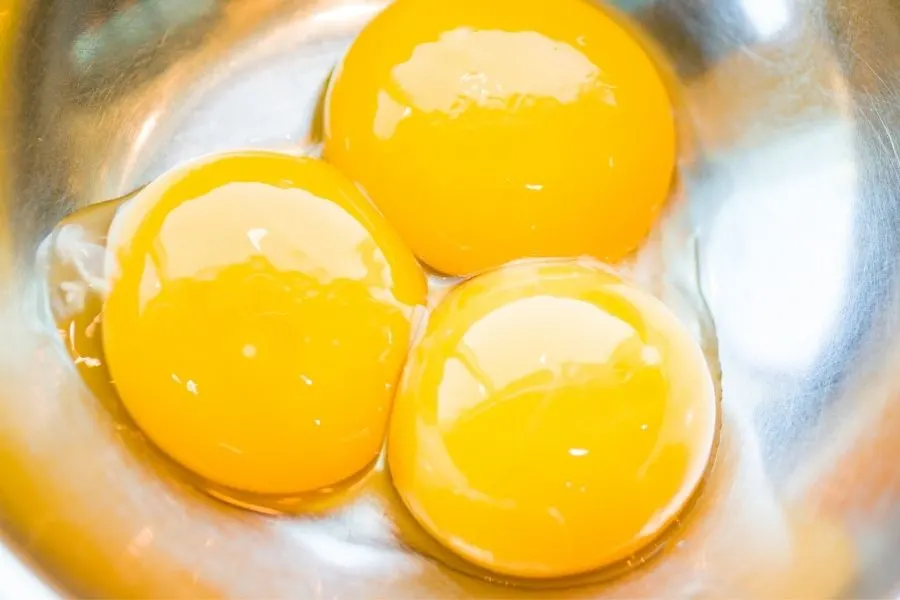Ever been to Japan and seen their lovely, orange-yolked eggs ?They’re the stuff dreams are made of. They might also taste a little better, although it could just be our programing of orange yolk=good egg.
But why are Japanese eggs so orange ? Why are they so strikingly colored, when other eggs just aren’t as impressive ? Today we’re gonna find out just why that is, and how it affects the eggs.

Why are Japanese eggs so orange ?
Japanese eggs have a very orange yolk because of what the chickens are fed. Foods high in carotene like peppers, carrots, chili flakes, and paprika all help pigment the hen’s yolk. other options include marigold and rose petals, which also help turn the yolk orange.
There is no significant increase in feed quality, instead there’s a big demand for beautiful orange eggs. In Japan a raw egg is common alongside many dishes, so the yolk needs to be beautiful and healthy looking.
What does an orange yolk mean ?
Traditionally an orange yolk means the hen has a varied diet with vegetables and grains, along with whatever insects or grub they may find in a typical farmer’s yard.
Nearly all the eggs humans consume come from industrial egg farms, which means the chickens don’t have access outside. Their feed is calculated for nutrition and the farm’s profit.
Why are American eggs yellow ?
In America the primary chicken feed is corn. Corn is plentiful, easy to grow, and fairly cheap. So the majority of chicken feed is corn, which affects the hen’s egg color.
If all the color she can draw is from corn, the yolks will be yellow or pale yellow. This doesn’t have a significant impact on the nutritional value of the egg.
An egg yolk’s color can be tricked with very pigmented foods. This des not mean that a yellow yolk always means a poor quality egg. Rather the egg’s quality is derived from the way the chicken is treated. If it has room to move, nest, flutter from a perch to another, socialize, etc.

Read also: Why Are Eggs So Cheap ?
What do chickens eat ?
Chickens are actually meant to have a very varied diet. Originally they ate whatever they could find among the grass, like insects, worms, a few seeds, etc.
But since chickens have been domesticated and grown as farm animals for so long, humans don’t remember that much of what chickens used to eat. We do know what we feed them nowadays though.
Chicken feed is made mostly of whole grain low salt and low sugar pellets. They also need some protein in their diet, along with vitamins and minerals.
Some of the most common items in their pellets are ground corn, oats, soybeans, ground oyster shell, or limestone, calcium, sunflower seeds. Depending on the chicken’s size, age, and whether she’s laying or not, the percentages of the ingredients may change.
For example laying chickens (called hens) always need a supplement in minerals and vitamins. The egg shells are made up of calcium, which the hen stops using for her bones when laying.
In the case of most hens, used for industrial egg farming, this is a serious issue and calcium supplements are a big part of their diet.
Aside from all this, hens may have some natural food coloring added into their feed, to make the yolks orange. Heavily pigmented foods like paprika, chili flakes, marigold petals all contribute to the yolk’s color.
Most eggs in Japan are caged eggs
Now, you may have heard that orange yolks come from healthy, free range and organic hens. That’s both true and false.
It’s true in that a healthy hen will be able to run about, spread her wings, breathe fresh air, eat varied meals and peck the ground as she pleases. The yolks turn orange from the good meals and the good life.
It’s also false because, as you’ve seen, just the color of the yolks can end up meaning nothing. Battery eggs can be orange, if their feed has heavily pigmented food in it. And in Japan that’s pretty much the norm. Yes, there are free range chickens over there. But there isn’t enough space to make all the farms free range.
Before you get all worked up about Japan and their battery cages, please understand this. Japan has very limited land, there is a very slim chance of letting the chickens out into the fields. There is no room for that.
They’re slowly making improvements to the way the hens are kept, in terms of space, but there’s only so much room. Poultryworld brought a very good point to light: free range eggs are more work, and this will severely impact the workers.
If Japan changes to this (which there is little actual, space-on-the-floor room for) the workers have to be taken into account. The most probable options Japan will go for are aviary type farms. It’s still a step up from battery cages.
Read Also:Maki VS Temaki
Why are Japanese eggs so clean ?
Another interesting point about Japanese eggs is why they’re so damn clean. Well, Japanese dishes often feature a raw egg on the side. The egg shells themselves have to be clean, to make sure no grit or bird poop will contaminate the egg inside.

There’s also their approach to Salmonella. Some countries wash their eggs nd keep them refrigerated, and some don’t wash them and keep them at room temp.
And finally, there’s that classic Japanese approach to nearly everything. Clean, well thought out, designed to be beautiful and efficient at the same time.
The fact that you can see that in something as mundane as their eggs is a testament to their dedication to perfection. If you ever get the chance to eat an egg in Japan, treasure it !

